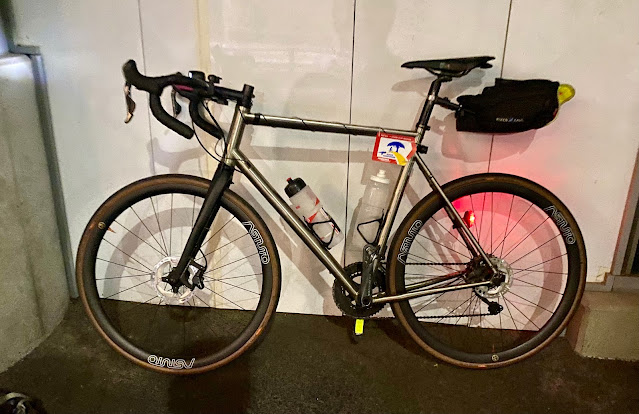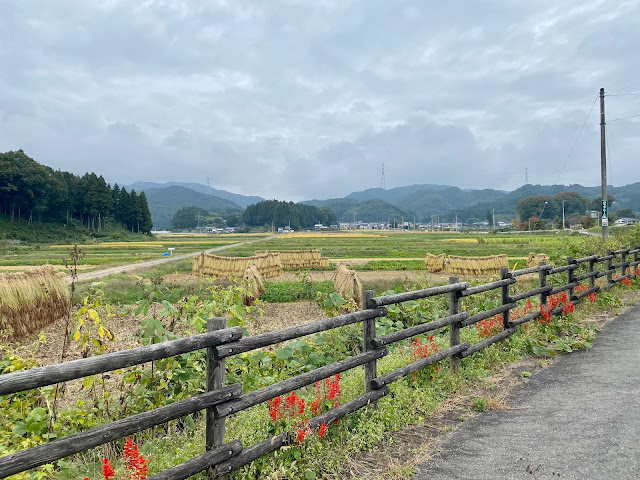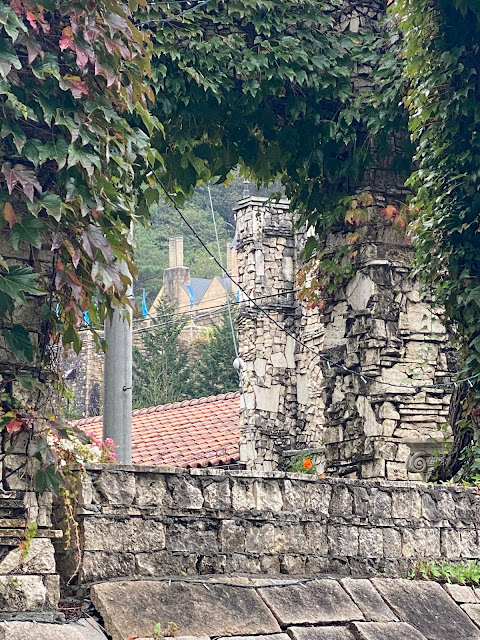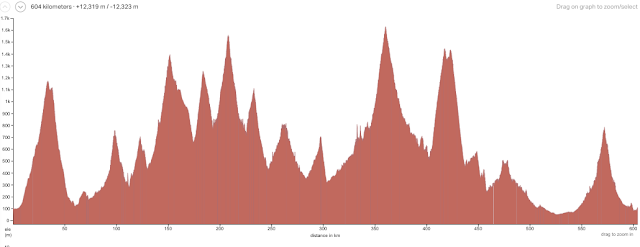 |
| Lake Haruna ... after our first 1000m elevation gain. |
 |
| RAMAX ready to go. One bag on the frame, plus a rucksack with some light gear. |
After my epic ride of the Fukushima SR600 and Covid-19 DNS at Cascade 1200, I wanted to try one more SR600 this year. Jerome said he would join, and we planned it for the week of Oct 10-14 when we would both be in town and hoped to have some time during the week, and I could celebrate my birthday.
I suggested AJ-Gunma's new SR600 Joumou Sanzan course, because it is easy to get to/from, and while it goes through an area I am generally familiar with, I have done only small segments of the actual route, and only a couple of the 13 climbs.
The title of the ride is written in romanized characters, but Joumou is 上毛, a name for the area of Japan that makes up roughly modern day Gunma Prefecture. Sanzan is probably 散々 which has various meanings, but I guess here means "more than enough!" "Sanzan" also might mean 三山 or "three mountains", or even "lots of mountains". Anyway, the ride covers a lot of Gunma and as an SR600 has well over 10,000 meters of climbing, so more than enough mountains.
Gunma has plenty of excellent riding territory, including most of this route. Gunma has beautiful onsen (hot springs), including famous ones such as Kusatsu, Ikaho, and Shima, all of which are along this route, and many other smaller onsen of all types -- ancient, rustic, luxury retreats, local day spas, and more! Gunma has lots of mountains that jut up sharply at the top, exposed rock lumps as if stones had been turned on their side and stood upright on top of forested hills ... in a way vaguely reminiscent of, but smaller than and with more rounded and crumbled sides than, some of the Dolomites in Italy, or the mountains of Guilin in southern China. Gunma has dozens of ski areas. Gunma also is very convenient to Tokyo. Takasaki is less than an hour from Tokyo by shinkansen -- and all shinkansen going toward Niigata or Nagano/Kanazawa stop in Takasaki. There are 2 other shinkansen stops in Gunma -- Annaka Haruna, between Takasaki and Karuizawa, and Joumou Kogen, near Minakami in the north of the Prefecture.
But I think Gunma has an image problem. First, what is Gunma? Some people will think of it as a distant part of the Kanto megalopolis, with low elevation areas of urban sprawl and rice cultivation around Takasaki, Maebashi, and Kiryu that are as hot in summer as adjacent Saitama, and do not have much in the way of physical separation from Tochigi or Saitama. Or is Gunma represented by the mountainous western and northern parts of the Prefecture, where only a small fraction of the population lives?
Gunma is landlocked. But unlike other big landlocked prefectures, it lacks one dominant headline attraction. Shiga Prefecture has Lake Biwa, a major landmark that dominates its landscape. Gifu Prefecture has Hida Takayama and Shirakawa village, a UNESCO World Heritage Site and major tourist destination. Yamanashi has, well, Mt. Fuji (at least the northern half of the mountain). It also has the southern side of Yatsugatake around Hokuto city, and a wealth of history including Takeda Shingen, pre-eminent feudal lord who struggled unsuccessfully to unite medieval Japan and many of whose innovations were eventually adopted by the victorious Tokugawa Ieyasu. Tochigi Prefecture has Nikko, a major tourist attraction, as well as Nasu Kogen, where the royal family has a guesthouse. And Utsunomiya, the gyoza capital of Japan.
Nagano Prefecture has so much, it is difficult to know where to begin. Nagano had its own winter Olympics, for goodness sake. It has its soba, its miso, its apples, its cultural monuments, it has served as the home to many distinguished personages, it some of Japan's best ski areas (Hakuba, to start, Nozawa Onsen to continue, and many others); it has the longest average lifespan in all Japan (recently exceeding Okinawa); it has the fanciest countryside resort towns (Karuizawa, Tateshina), the highest paved road in Japan (up Norikura), and much much more. If people in Japan hear "Shinshu" or "Shinano" (two pre-modern terms for the Nagano area), they think of good things, cultured countryside, valued traditions and foods. Heck, the area around Lake Suwa in Nagano has evidence of some of the earliest (Jomon and pre-Jomon) human settlements in Japan. People in Japan poke fun at Saitama (and Chiba, and yes, Gunma), but no one, not even Tokyo nor Kyoto folk, makes jokes at the expense of Nagano!
Gunma? Well, Gunma has Konnyaku. Gunma produces more of it than any other prefecture in Japan. It also has the Konnyaku Park, a theme/amusement park about ... konnyaku.
And Gunma has Gunma-chan.
 |
| Gunma-chan |
Gunma has some major onsen towns ... Kusatsu, Ikaho, Shima, and plenty of others. Kusatsu is nationally famous ... almost as much so as Gero onsen in Gifu, or Beppu in Oita, or Atami and Hakone in Shizuoka. In some surveys, Kusatsu comes in ranked as the #1 onsen in all of Japan. But just about every prefecture in Japan has onsen of which it is proud. Kusatsu may be in the current lead, but it is not a clear #1, and it is wedged in the NW corner of Gunma, far from the rest of the prefecture.
If more evidence were needed of Gunma's branding issue, our second big climb on the first day of our ride was from Kurabuchi west up to Nido-age Pass and the plateau in Gunma on the north side of Mt. Asama. Mt. Asama straddles the Nagano/Gunma border. Anyway, this plateau is called "Kita Karuizawa" or "North Karuizawa". The Karuizawa (Nagano) brand is so strong that the neighboring area of Gunma piggybacks on the name, rather than trying to create its own brand. Sadly, Kita Karuizawa is a 45 minute drive, mostly up a mountainside, from the Karuizawa shinkansen station, quite remote. And while remoteness has its attractions, let's just say that it has not been quite as successful at developing the local economy, attracting celebrity Tokyoites' second homes, or boosting real estate prices as the main Karuizawa.
After this climb, we descended National Route 146 toward Naganohara town. What? NAGANO-hara? They really should rename the town something else. Why not call it "Lower Tsumagoi", or "Kusatsuguchi" (the name of its train station, as the train does not go up the hill to Kusatsu itself)? Why weaken your brand by using the same name as Nagano ... even if it has been called this for a thousand years?
The next day, I wanted to buy some fruit to send back to Tokyo after leaving our lodgings in Shima Onsen. I was told that the road back down the valley is called the "Ringo Kaido" (the "Apple Highway") and that there were stands where I could buy a box of apples and have them shipped back to Tokyo. We were even given coupons to cover the cost of a 10kg box of apples ... part of the government's support for tourism recovery post-pandemic. After consultation with a lady running the apple stand where I stopped, I decided on a box including 3 different types of apples that she guaranteed were excellent flavor for eating (as opposed to for use in apple pie). The varieties were Shinano Gold, Shinano Sweet, and Youkou. "Shinano" ... is another name for Nagano! Gunma is growing Nagano apples, and selling them even to tourists who are visiting Gunma to explore! Why not Joumou Sweet and Joumou Gold? Or better yet, Agatsuma Sweet and Agatsuma Gold?
 |
| Gunma-chan appears on the JA Agatsuma apple label and the Agatsuma "Gunma Quality" seal |
Gunma can be the same apple tree, the same variety as the shinano brand ... but change the name to signify that they were grown in Gunma! Of course, the part of Nagano between Nakano and Iiyama is famous for its apples (as is the area of Aomori Prefecture around Mt. Iwaki and Hirosaki, which also has an "Apple Road" -- actually lined with apple orchards as far as the eye can see). Maybe Gunma growers can sell for a higher price with the "Shinano" variety? Gunma ... is not really famous for its apples, and it definitely is not going to become famous for them as long as the apples are called "Shinano" ... though in fact the ones I ate were delicious.
I think Gunma needs a brand consultant. I would be happy to advise on this topic for a modest fee, slightly less than the 200 million yen that Takahashi-san, the Dentsu alum, charged four companies for "arranging" their Tokyo Olympic sponsorship opportunities. The payoff could be immense, for Gunma.
--------------------------------------------
Our plan to ride the SR600 fell apart even before we started. I had suggested taking an early train to Takasaki for an 8AM start on the 12th. But Jerome needed to be back in Tokyo on the 14th during the day, so we decided on a 6AM (later switched to a 5AM) start, with hotel in Takasaki near the station. This meant planning to do the ride in around 48-50 hours, rather than the 55-60 hour plan I had made for the Fukushima SR600 a few months ago. It meant a very aggressive schedule the first day, with the early start and a ride of well over 6000 meters elevation gain and 260kms to get to Shima Onsen.
(If I had been doing this on my own, I would have done a 55-60hr plan, with the 8AM start, and rested the first night at Kusatsu, after 185kms and 4300 meters elevation gain.)
On the 11th as we were heading out, Jerome said that he needed to be back in Tokyo sooner than expected, by Thursday afternoon, to prepare for his next international business trip - heading out on Saturday. I could see that he was just too busy to do this ride. I appreciated him trying to accommodate me -- a great birthday gift -- but his work seems busier than at any time since pre-pandemic, and he could not get enough time away to make it practical to really have a go at it. He was doing a lot of business during the ride, taking phone calls and sending emails--which he can do because he rides faster than me. He is not in the shape of May/June, but he is still a beast climbing hills, grinding up in big gears faster than I can spin in my lighter ones.
If I were to do this ride again with Jerome, I would get to Takasaki early enough to sleep by 830PM (instead of close to midnight), and start a couple hours ahead of him with the idea that he would catch me the first night after 18 hours or so on the road, and we could then ride together the second day. That is what we did on the 600km ride to Hamanako in April, and it worked well -- I started 2 hours ahead, he caught me after 450kms, and we rode together to the finish. Indeed, when we completed the SR600 Fuji back in 2015, I started 2 hours ahead and he and one other friend (Tanaka-san from Aichi) never caught up (except at the brief sleep stop in Ueda), but I was motivated the entire time, and we could celebrate together with breakfast at the finish.
Anyway, we got to Takasaki after 9PM, and by 930PM had checked into the Route Inn Takasaki Eki Nishiguchi (which is over 700 meters north of the actual station Nishiguchi). We went to the main drag looking for some good food ... but nearly every place was closed except bars that served only "tsumami" (snacks). We ended up settling for fried, somewhat greasy kushiyaki -- not ideal pre-ride nutrition.
 |
| We explore beautiful Takasaki |
 |
| Back at the station for our 5AM start. |
We were up before 430AM and at the start ready to go within a few minutes of our scheduled 5AM departure. The route started with a long climb, 25kms to Ihaho Onsen on the NE side of Mt. Haruna. I climbed slowly, warming up and knowing not to push hard because of what lay ahead.
 |
| All these photos from the climb to Ikaho |
 |
| What a great time of day to be up and about ... once up and about. |
 |
| Finally, the checkpoint. |
After the checkpoint at Ikaho, I expected a long descent into Annaka. But actually Ikaho is around 800 meters elevation or a bit higher, while the top of the climb was at 1170 meters and at least 7-8kms ahead. Still, it was a beautiful morning, low traffic, and nice views, so I was not in a mood to complain.
 |
| Nice views from above Ikaho |
 |
| Up on top ... is this the crater? |
After going across the flat crater of Mt. Haruna, then past Lake Haruna, we climbed briefly over the southern edge of the crater, then started a steep descent down to Annaka. We seemed to head SE for a long time, and all the signs said we were going toward Takasaki. And we did go through the Takasaki outer sections, but eventually turned SW and reached the second checkpoint, Annaka Station.
From there, we headed south toward Tomioka, then west toward Shimonita, the third checkpoint, climbing gradually. This section of the ride was the most familiar, as we took roads I have traveled often, though usually heading to the NW or SE, rather than this time to the SW then West. For many sections around here, you take the same road across a valley whether your ultimate intention is SW or SE.
 |
| Checkpoint. |
 |
| Typical Gunma scene - konnyaku field, solar PV, power lines, road. |
 |
| Checkpoint. |
After Shimonita and a brief section to the west, we did our second real climb, over the shoulder of Mt. Myogi, with the top at Nakanotake Shrine, home to a 20m tall gold statue. This was a lovely climb up and a nice descent to the north, and I will definitely try it again when in the vicinity.
 |
| We did not actually climb Mt Myogi ... looks quite technical for rock climbers even. |
 |
| Turned here onto the Myogi climb |
 |
| At the top. Side profile of Jerome! |
 |
| Cosmos (flowers) everywhere on this trip! |
After dropping into the valley, between Yokogawa and Matsuida, we turned east on Route 18 and passed a hundred meters or so from GS Astuto's Gunma base, now including a rider's cafe and some overnight accommodations, perfect for a stop in the middle of a long ride ... but not at 1145AM after only 6 1/2 hours on the road. We said hi to Tim and Naoko Smith, the proprietors, filled our bottles and accepted some offered konnyaku jelly snacks, and continued on our way. Of course, the bicycle I was riding this trip was my RAMAX all road maximum adventure bike, which was designed by Tim.
 |
| Tim ... with riders' guest room to the rear. |
 |
| Naoko, with the other guest room behind her. |
 |
| Now serving. |
By now it was painfully clear we were behind schedule, and had not a moment to lose.
We headed north on Gunma Route 33, the Shibukawa-Matsuida Line, went over another pass not quite as high as Mt. Myogi's shoulder, then descended again, to Kurabuchi. There we stopped for lunch at a cafeteria in front of the town hall. Now it was time for our second big climb, 22kms, with elevation gradually increasing from 400m to 1400m, ending at Nido-age Pass. It was already well past 2PM as we started. I climbed until 3PM, then pulled over for some food and a 5-minute rest, flat on my back.
The road was well marked with indicators of the remaining distance to the pass, often every 100 meters or so. 8.5kms to Nidoage Pass, 8.4kms ..., 8.35kms, ... 8.1kms. Overkill. The markers crept by. Around 4.5kms from the top, I adjusted my seatpost, elevating it maybe 5mms. It had felt a bit on the low side, and well into this climb my left knee had started to develop an occasional twinge -- something that is not a normal part of my long ride experience. The slightly higher seat resolved it immediately, and I could kick myself for not having adjusted it hours earlier to get a bit more power and less pressure on the knee.
 |
| Only 0.8km to Nidoage Pass |
 |
| From the pass looking toward enclouded Mt. Asama. Signage for Kitakaruizawa. |
 |
| On the downhill to Naganohara. |
I found Jerome waiting at a pull-out in the road, a bit below the pass. Jerome said he had been there quite awhile, not surprising given my pace and earlier rest, as well as the seat adjustment stop. We went together the last few hundred meters to the top and planned our next move.
It was just 4PM, with perhaps another 80-90 minutes of daylight. We would descend nearly 25km and back down to 660m elevation, to Naganohara, reachable around 5PM. From there, the route involved (1) a 600m climb (steep and with traffic) to Kusatsu, (2) an 800 meter climb on National Route 405 to Lake Nozori, (3) a 373 meter climb on Gunma Route 55, and (4) another 380 meter climb up to the dam above Shima Onsen. So realistically, with 600m up, an hour to stop for dinner around 7-8PM at Kusatsu, and nearly 80kms distance and 1600m of climbing after dinner, we were looking at at very, very late night.
Since we already knew that we would not complete the ride, there did not seem much point. We had already been riding for 11 hours and 3700m of climbing, and we started looking at more direct routes to our lodging.
We descended toward Naganohara, but took a short cut down the last part of the hill (near Furumori Golf Club) and then continued east on Route 145 to Nakanojo. There we ate a decent and well-deserved meal at a yakitori place. Then we did the gradual climb up to Shima onsen. It was only 20kms, and perhaps 350 meters of elevation gain as we would not go all the way to the top of the dam. My stomach was complaining as I rode up that hill right after dinner, so I took it easy. We arrived at our hotel before 9PM and could actually enjoy the onsen, get a decent night of sleep, and wake in time for a second trip to the onsen, a 730AM breakfast seating, and an 830AM departure.
 |
| Not bad -- includes entryway, rotenburo, breakfast, and coupons for shopping, all for 7850 yen, or 3900 yen each. Go to Travel! |
 |
| Well-rested and ready for day two |
 |
| We could not see this landmark looming above us when we arrived at night! |
 |
| Most of the town was closed on a weekday morning. |
 |
| Descending the "ringo kaido". |
 |
| Takebuchi ringo-en (I was recommended to go to Saito ringo-en ... which it turns out is another kilometer or so down the road.) |
 |
| Beautiful Gunma! |
After riding back to Nakanojo, with a stop to purchase Nagano-branded apples, we did a gradual climb up to Lockheart Castle.
 |
| At the castle entrance |
What is Lockheart Castle? It is a Scottish baronial mansion built in 1829 near Edinburgh ... that was disassembled brick-by-brick, shipped to Japan, and rebuilt on the top of a hill in Gunma in 1988 -- near the peak of the Japanese "bubble economy" when life was good, money was free, and Japan was going to party all night long and take over the world. The castle charges admission for curious tourists, and allows Gunma couples from nearby Numata, Minakami, and Shibukawa the opportunity to get married in a Scottish mansion without leaving Gunma. We did not go inside.
 |
| From the official Gunma tourist guide - Gunma Excellence! |
From Lockheart Castle, it was a steep descent to Numata, then we turned south for another 45 kms of very slight downhill to get back to Takasaki Station.
 Bet Bet |
| Between Numata and Takasaki |
The first day was a good, hard ride that was memorable, almost epic. And the second day we enjoyed an easy recovery ride.
Day 1 Strava track is here.
Day 2 Strava track is here.














